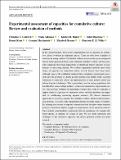Files in this item
Experimental assessment of capacities for cumulative culture : review and evaluation of methods
Item metadata
| dc.contributor.author | Caldwell, Christine A. | |
| dc.contributor.author | Atkinson, Mark | |
| dc.contributor.author | Blakey, Kirsten H. | |
| dc.contributor.author | Dunstone, Juliet | |
| dc.contributor.author | Kean, Donna | |
| dc.contributor.author | Mackintosh, Gemma | |
| dc.contributor.author | Renner, Elizabeth | |
| dc.contributor.author | Wilks, Charlotte E. H. | |
| dc.date.accessioned | 2020-11-02T10:30:11Z | |
| dc.date.available | 2020-11-02T10:30:11Z | |
| dc.date.issued | 2019-12-05 | |
| dc.identifier | 270943523 | |
| dc.identifier | 66e4f842-ad31-4ee9-a0a9-43aacd03b94f | |
| dc.identifier | 85071029352 | |
| dc.identifier.citation | Caldwell , C A , Atkinson , M , Blakey , K H , Dunstone , J , Kean , D , Mackintosh , G , Renner , E & Wilks , C E H 2019 , ' Experimental assessment of capacities for cumulative culture : review and evaluation of methods ' , WIREs Cognitive Science , vol. 11 , no. 1 , e1516 . https://doi.org/10.1002/wcs.1516 | en |
| dc.identifier.issn | 1939-5078 | |
| dc.identifier.other | crossref: 10.1002/wcs.1516 | |
| dc.identifier.uri | https://hdl.handle.net/10023/20877 | |
| dc.description | Funding information: H2020 European Research Council, Grant/Award Number: 648841 RATCHETCOG | en |
| dc.description.abstract | In the current literature, there are few experimental tests of capacities for cumulative cultural evolution in nonhuman species. There are even fewer examples of such tests in young children. This limited evidence is noteworthy given widespread interest in the apparent distinctiveness of human cumulative culture, and the potentially significant theoretical implications of identifying related capacities in nonhumans or very young children. We evaluate experimental methods upon which claims of capacities for cumulative culture, or lack thereof, have been based. Although some of the established methods (those simulating generational succession) have the potential to identify positive evidence that fulfills widely accepted definitions of cumulative culture, the implementation of these methods entails significant logistical challenges. This is particularly true for testing populations that are difficult to access in large numbers, or those not amenable to experimental control. This presents problems for generating evidence that would be sufficient to support claims of capacities for cumulative culture, and these problems are magnified for establishing convincing negative evidence. We discuss alternative approaches to assessing capacities for cumulative culture, which circumvent logistical problems associated with experimental designs involving chains of learners. By inferring the outcome of repeated transmission from the input–output response patterns of individual subjects, sample size requirements can be massively reduced. Such methods could facilitate comparisons between populations, for example, different species, or children of a range of ages. We also detail limitations and challenges of this alternative approach, and discuss potential avenues for future research. | |
| dc.format.extent | 15 | |
| dc.format.extent | 2392830 | |
| dc.language.iso | eng | |
| dc.relation.ispartof | WIREs Cognitive Science | en |
| dc.subject | Comparative psychology | en |
| dc.subject | Cultural evolution | en |
| dc.subject | Cumulative culture | en |
| dc.subject | Developmental psychology | en |
| dc.subject | BF Psychology | en |
| dc.subject | T-NDAS | en |
| dc.subject.lcc | BF | en |
| dc.title | Experimental assessment of capacities for cumulative culture : review and evaluation of methods | en |
| dc.type | Journal item | en |
| dc.contributor.institution | University of St Andrews. School of Psychology and Neuroscience | en |
| dc.contributor.institution | University of St Andrews. School of Management | en |
| dc.identifier.doi | 10.1002/wcs.1516 | |
| dc.description.status | Peer reviewed | en |
This item appears in the following Collection(s)
Items in the St Andrews Research Repository are protected by copyright, with all rights reserved, unless otherwise indicated.

